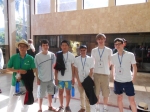Thursday 25th July
There is commotion at the adjacent (Netherlands?) table at breakfast when a large iguana steals a piece of bread then climbs onto a low-hanging branch to gloat over the spoils and relieve itself into their ceviche. Geoff and I also have some difficult encounters with the locals ahead today, as it is the first day of co-ordination.
This is the process by which the exam papers are marked. Geoff and I have looked at the UK students’ scripts, as have a team of local markers, called co-ordinators, who are split between the six questions. In an ideal world, all parties agree on the appropriate mark, so we can sign and head to the beach. In practice, however, the co-ordinators have very little reading time per solution, and are also responsible for ensuring the mark schemes are consistently applied.
Geoff has the 9am slot for Q4. Despite having prepared meticulous analysis of each UK student’s diagram dependency, we sign for 42/42 in a matter of seconds. Not such a baptism of fire after all. I am dealing with Q5 after lunch. They feel that Sahl has not finished the problem. I explain his argument in a slightly less minimalist fashion and they agree, getting the 41/42 we were looking for. We finish the day with Q1, which proves as straightforward as Q4.
Everyone is very pleased with progress so far, but also aware that tomorrow will be the tricky day, with the three hardest questions, including two which feature long combinatorial essays rather heavily. Geoff and I retire early to immerse ourselves in mathematics.
In the end I do spend a token amount of time asleep. Q6 is the main cause of my insomnia. Andrew has written a long argument that astonishingly combines both official solutions. Unfortunately he claims some results as trivial which the model answer devotes up to a page to proving, so we fear 6 is the best we can hope for, though explaining what is going on may take some time. Meanwhile Matei has come up with a very satisfying original argument, but has run out of time to finish it. In order to convince the co-ordinators that this will work, I cobble together the final steps and practice my speed-LaTeX while the sun rises.
Friday 26th July
First thing in the morning, and Geoff is trying to snare some partial marks on the hard geometry Q3. We feel Andrew deserves a point for some non-trivial progress in his rough work. The co-ordinators disagree and despite his entreaties we are forced to sign for a total of zero. The double combinatorics slog begins after lunch with Q2. We are able to get an extra mark for Gabriel bringing him to a total of 25 which will now surely be enough for a silver.
We are scheduled to be last to co-ordinate Q6, at 5.30pm. Aware that our arguments might take a while, and reluctant to hold up the machinations of the entire competition, we loiter and hope for an earlier slot. We end up with the problem captain for Q6 and the chief co-ordinator for all problems, so there would be no higher authority to resolve any disputes apart from an unprecedented (for the UK) appeal to the jury.
Daniel’s work turns out to be the main problem. He has not had much time, so has done the calculations for the increments of the inductive construction, and merely described how the induction itself works. The mark scheme looks very rigid, but appears to offer 4 marks for this, so I ask for that, and predictably the co-ordinators look surprised. We wrangle for a very long time indeed, but in the end I’m unable to convince them that despite the lack of proofs of the more technical part of the solution it is still worth at least 3. This extra mark would have earned Daniel a gold medal, so it is a shame, but he can perhaps draw some consolation from the fact that the regime was undoubtedly applied very fairly.
Matei and Andrew’s arguments also require lots of attention, and I am glad I prepared thoroughly, but in the end we get the 5 and 6 respectively that we wanted. They are now ensured strong gold medals. Geoff and I retire to the bar to toast what has been a record-breaking performance by the team, coming 9th overall, and top of the EU by some margin.
There follows the final jury meeting, where speeches are made by various team leaders, before the decision on the medal boundaries. There are no real controversies, and we end in good time to celebrate with our success and friends’ successes (not least a 15th place for Australia and top-ten individual score for AUS2 Alex Gunning) late into the night. I fear the supplies of Cachaca have been hit rather hard.
Saturday 27th July
The optional morning excursion to the nearby town of El Rodadero is generally spurned in favour of a lie-in and a final chance to enjoy the beach and the pool on the roof of my hotel. Since their well-deserved success may necessitate press releases and the like, the team are particularly encouraged to avoid obvious sunburn for the inevitable photos later.
The now-familiar convoy of buses gathers at dusk to transport the IMO to the nearby Quinta de San Pedro Alejandrino, site of Simon Bolivar’s impressive tomb, and location for the closing ceremony. First there are several speeches and performances from traditional singers and dancers. The mixing desk suffers some unfortunate problems, so the sound engineering for the ridiculously skilful young accordion player consists of a technician walking a single microphone from one side of the instrument to the other as the register changes.
The main event is the presentation of the medals. The UK students all do a good job of getting their Union Jacks in front of the competing flags from adjacent competitors. The space in front of the stage turns into a bit of a scrum of photographers. I turn out to be substantially bigger than the average South-East Asian mathematician, and so get some particularly suitable shots of our gold medallists.
During a further long sequence of dancing, everyone starts to drift away back towards the closing dinner at our Irotama hotel. It turns out that the British Maths Olympiad booklets have finally arrived at this late hour. Gabriel and his new friend from the Irish delegation do an excellent job of speedily distributing them amongst all the teams. After a slow start, the dance floor gradually fills while a table of deputy leaders watches on with a mixture of enthusiasm, concern and indifference. Some final goodbyes are said, others plan to chat the whole night away. This year’s IMO draws to a close.
Sunday 28th / Monday 29th July
We leave for picturesque Santa Marta airport after breakfast. It appears that some of the team have spent a non-zero time asleep. The short hop to Bogota is almost entirely made up of mathematicians, and there are plenty of paper pads and Rubik’s cubes out in the departure lounge (remembering of course that compasses can’t be taken in hand luggage).
A short change in Bogota is enlivened when the ever-suspicious Andrew Carlotti is summoned by the police. It turns out to be merely a random inspection… Geoff and I muse over plans for next year, and I learn that The Glass Bead Game is a very useful tool for getting to sleep much earlier than natural.
After a layover and much-needed triple espresso in Madrid, and an initial aborted landing at windy Heathrow, everyone is united with adoring parents and other fans. Despite Geoff’s best efforts, his dream of a flash-heavy welcome by the national press fails to come to fruition. We live in hope for next year.


































